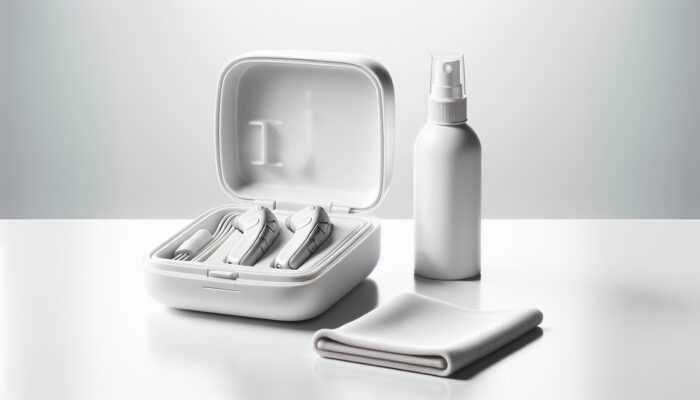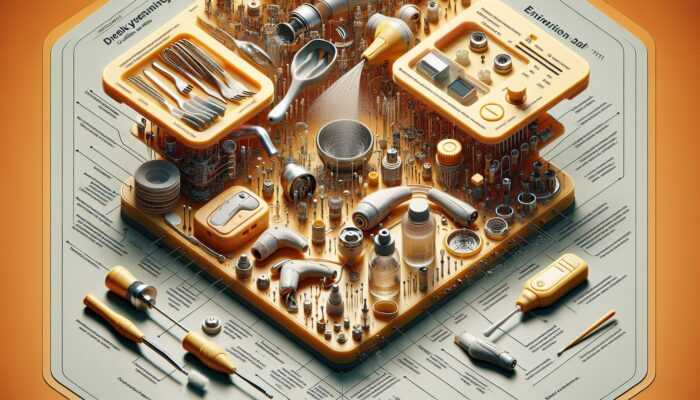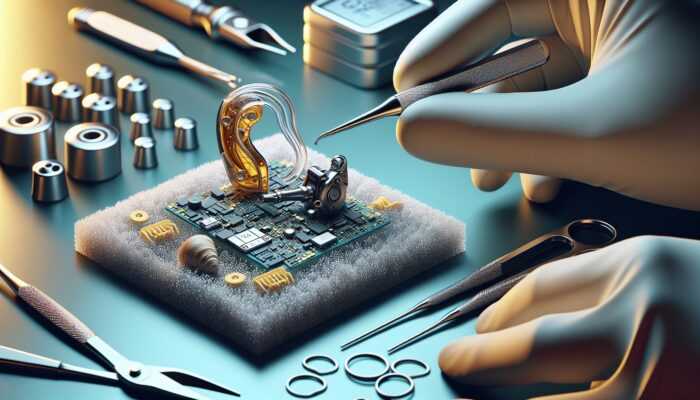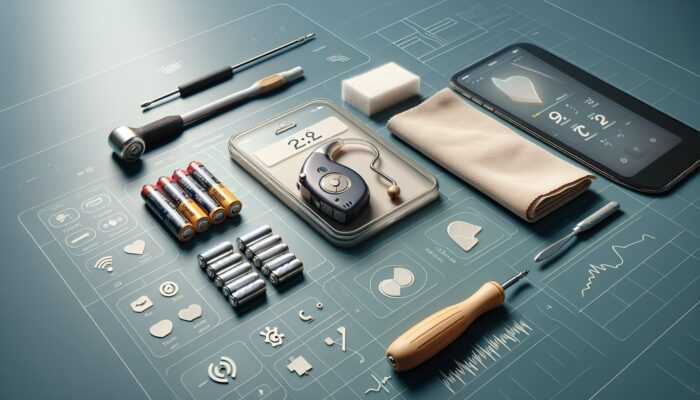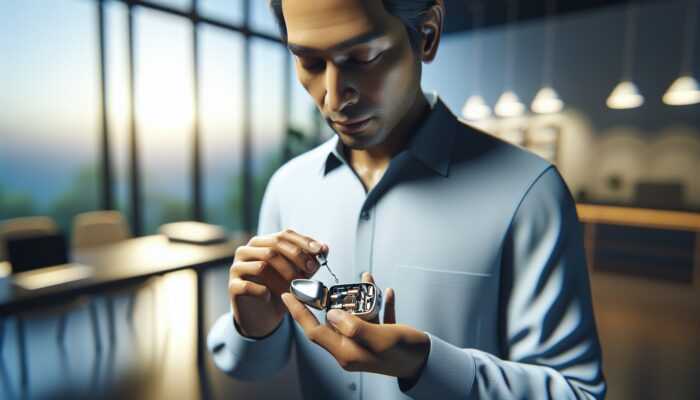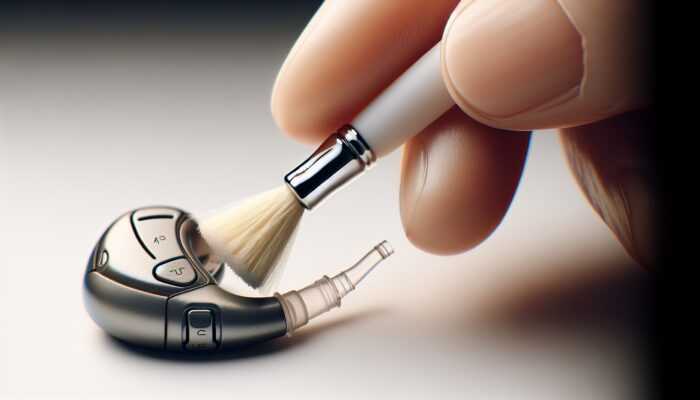Mastering Your Hearing Aids for Optimal Hearing Health
Gaining a comprehensive understanding of your hearing aids is the vital first step in successfully adjusting to wearing hearing aids. This knowledge empowers users to take charge of their auditory health, enabling informed decisions that positively impact their hearing experience. With an array of hearing aid types available, it is crucial to identify the model that best fits your lifestyle and personal needs to maximize your auditory well-being.
Exploring Different Types of Hearing Aids

Selecting the right type of hearing aid can significantly enhance your overall auditory experience. The three primary categories include: behind-the-ear (BTE), in-the-ear (ITE), and completely-in-canal (CIC) hearing aids. BTE models are highly versatile and cater to a variety of hearing loss levels, making them a popular choice globally. These aids rest comfortably behind the ear, utilizing a tube to direct sound into the ear canal, thus providing clarity and comfort.
ITE hearing aids, designed to fit within the outer ear, present a more discreet option for users seeking minimal visibility. Despite their compact size, they often feature advanced options such as volume control and multiple listening programs. In contrast, CIC aids are the most inconspicuous, fitting deep within the ear canal and catering specifically to individuals with mild to moderate hearing loss.
Each type of hearing aid offers unique features tailored to meet individual needs. For instance, BTE models often boast longer battery life and can accommodate larger amplifiers, while ITE and CIC options prioritize aesthetics and comfort for users who favor discretion. By thoroughly understanding these differences, you can select a hearing aid that not only addresses your hearing requirements but also integrates seamlessly into your lifestyle.
Key Components of Hearing Aids Explained
A deep understanding of the key components of your hearing aid is essential for effective troubleshooting and maintenance. The primary parts include the microphone, amplifier, and speaker. The microphone’s role is to capture sound from the environment and convert it into an electrical signal, marking the beginning of your auditory journey by allowing external sounds to reach your ears clearly.
Once sound is captured, the amplifier takes over, boosting these signals to ensure they are louder and clearer, tailored to your specific hearing loss profile. This amplification is particularly crucial in noisy settings, enhancing your ability to hear in challenging environments. Ultimately, the speaker transmits the improved sound directly into your ear canal, completing the auditory transmission process.
By comprehending the function of each component, users can effectively communicate their needs and preferences to their audiologists. Whether you find yourself in a lively café in Paris or a serene library in Tokyo, having insight into how your hearing aids operate empowers you to optimize their performance across diverse listening situations.
Personalizing Your Hearing Aid Experience
Personalization plays a critical role in adjusting to wearing hearing aids, allowing users to modify their auditory experience according to individual preferences. Today’s modern hearing aids come equipped with various features, including volume control and customizable program settings that adapt to different sound environments. For example, many models enable users to switch between settings designed for quiet spaces, bustling streets, or lively social gatherings, ensuring optimal sound quality regardless of the situation.
Volume control is particularly important during the initial adjustment phase. Users can start with a lower volume and gradually increase it as they acclimate to their devices. This incremental approach helps mitigate auditory fatigue and discomfort, making the transition smoother.
Additionally, programming features allow audiologists to tailor hearing aids based on individual hearing loss patterns and preferences. This customization is especially advantageous for those navigating multilingual environments or culturally diverse settings, where auditory challenges may vary widely. By understanding and utilizing these personalization options, you can significantly enrich your listening experience and engage more fully with the world around you.
Essential Maintenance and Care for Longevity

Proper maintenance of your hearing aids is crucial for ensuring their longevity and optimal performance. Regular care not only prevents technical malfunctions but also enhances overall sound quality. Begin with a straightforward cleaning routine; use a soft cloth and a gentle brush to remove earwax and debris that may accumulate on the surface or within the internal components of your devices.
Equally important is proper storage. When not in use, always keep your hearing aids in a dry, safe location, ideally within a protective case. This practice shields them from moisture and accidental damage, both of which can drastically reduce the lifespan of your devices.
For users residing in humid climates, investing in a dehumidifier or drying kit can be beneficial. These tools effectively remove moisture from hearing aids, preventing corrosion and enhancing their overall functionality. By implementing these maintenance strategies, users can ensure their hearing aids deliver optimal performance and clear sound for many years.
Embracing the Initial Adjustment Period
The initial adjustment period when first using hearing aids is a pivotal moment. It involves more than just acclimating to the devices; it’s also about retraining your brain to recognize and interpret sounds that may have previously been muffled or unnoticed.
Establishing a Comfortable Wearing Schedule
Starting your journey with hearing aids can feel daunting, making it vital to establish a comfortable wearing schedule. Begin by wearing your hearing aids for short periods each day—perhaps an hour or two. This gradual method allows your ears and brain to adjust to the influx of new auditory information without becoming overwhelmed.
As you gain comfort, incrementally extend your wearing time. This step-by-step approach helps you acclimate to the acoustics of diverse environments, from bustling city streets to the peaceful silence of nature. Many users report initial fatigue after prolonged use, so it’s essential to listen to your body during this acclimatization phase.
It’s also important to remember that each individual’s adjustment journey is unique. Some may adapt quickly, while others might take longer. By setting realistic expectations and practicing patience, you will foster a more positive relationship with your hearing aids, ultimately enhancing your overall auditory experience.
Adjusting to New Sound Sensitivities

Adapting to new sounds is a significant aspect of adjusting to wearing hearing aids. Initially, you may find certain noises—such as the rustling of leaves or the hum of a fan—overwhelming. This reaction is completely normal as your brain acclimates to processing sounds that it hasn’t heard clearly in a long time.
As you continue to wear your hearing aids, your brain will gradually adapt to these new sounds, learning to filter out background noise while honing in on critical auditory cues. Participating in social activities can be particularly beneficial during this adjustment phase. Immersing yourself in conversations will help your brain associate sounds with context, making it easier to understand and interpret the meaning amid the noise.
It’s vital to acknowledge that this adjustment process requires time and patience. Celebrate small victories, such as successfully hearing a friend’s laughter or understanding a conversation in a busy café. These moments signify progress in your adjustment journey and reinforce your ability to navigate auditory experiences once again.
Tips for Ensuring Comfort with Hearing Aids
Comfort is a critical factor when adjusting to hearing aids. If your devices do not fit well or cause discomfort, you may be reluctant to wear them consistently, which can hinder your adjustment process. Start by ensuring that the fit is snug yet comfortable; it should not cause pain or excessive pressure on your ears.
If available, consider experimenting with different ear molds or tips. Custom molds can provide a more comfortable fit, minimizing irritation and improving sound quality. Additionally, don’t hesitate to take breaks as needed. If you experience discomfort, simply remove your hearing aids for a short period before reinserting them.
Regularly assessing your comfort level can guide you in making necessary adjustments. If discomfort persists, consulting with your audiologist can lead to modifications or recommendations tailored to your specific needs. Prioritizing comfort will enhance your overall experience and encourage consistent use, which is crucial in adjusting to wearing hearing aids.
Fine-Tuning Volume Settings for Optimal Listening
Finding the right volume is vital for easing into your hearing aids. Initially, it is advisable to start with a lower volume setting. This gradual introduction allows your auditory system to adapt without feeling overwhelmed. Many hearing aids are equipped with automatic volume control features that adjust to your environment, but manual adjustments may still be necessary during the adjustment phase.
As you become more comfortable with your hearing aids, gradually increase the volume until you find a level that feels just right. Engage in various settings—quiet rooms, bustling markets, or even outdoor environments—to gauge what volume works best in different situations.
Listening to your body is paramount. If sounds become overwhelmingly loud, do not hesitate to lower the volume. This personalized approach will ensure an optimal experience, facilitating smoother communication in your everyday life.
Implementing Daily Maintenance Practices
Daily maintenance of your hearing aids is essential for ensuring they function correctly and enjoy a longer lifespan. A little care can go a long way in preserving sound quality and prolonging battery life.
Effective Cleaning Techniques for Hearing Aids
Regularly cleaning your hearing aids is essential for maintaining optimal performance. Use a soft, dry cloth to wipe down the exterior, and a small brush to remove earwax or debris from the microphone and speaker openings. This simple daily routine helps prevent buildup that could compromise sound quality.
For users with ITE or CIC models, it is particularly important to keep the ear canal portion clean to avoid clogging. Occasionally, a more thorough cleaning may be necessary, which can be accomplished using specialized hearing aid cleaning kits available at pharmacies or audiology clinics. Adhering to a regular maintenance routine not only enhances performance but also extends the lifespan of your devices.
In humid environments, consider using cleaning wipes specifically designed for hearing aids. These wipes can effectively remove moisture and prevent corrosion, ensuring that your devices function optimally. By committing to these cleaning practices, you will enjoy a clearer, more vibrant auditory experience.
Best Practices for Battery Care
Proper battery care is crucial for hearing aid users. Hearing aids typically utilize either disposable or rechargeable batteries, each requiring distinct management strategies. For disposable batteries, always keep a few extras on hand to avoid unexpected outages, especially in remote locations where replacements may be difficult to find.
When storing batteries, ensure they are kept in a cool, dry place. Exposure to heat and moisture can significantly reduce battery life. If your hearing aids use rechargeable batteries, regularly check their charge level to guarantee your devices are always ready for use. Many modern models feature battery indicators, allowing users to easily monitor their power levels.
Consider investing in a battery tester to ensure reliable performance. This small device can quickly assess battery health, providing peace of mind. By effectively managing your hearing aid batteries, you can avoid disruptions in your daily life, allowing for seamless communication and engagement with the world around you.
Optimal Storage Solutions for Hearing Aids
The way you store your hearing aids when they are not in use can significantly impact their longevity. Always place them in a protective case to shield them from damage. This precaution is especially important if you share your home with pets or children, where accidental mishaps could occur.
For individuals living in humid climates, consider investing in a dehumidifier or drying kit specifically designed for hearing aids. These devices help eliminate moisture that can accumulate and corrode internal components. It is a crucial step in caring for your hearing aids, ensuring they remain functional and effective over time.
Furthermore, avoid leaving hearing aids in areas exposed to extreme temperatures, such as a car or a bathroom. Geographic regions with varying climates, such as tropical areas or cold winters, can influence how you store your devices, so adapting to your environment is vital.
Effective Moisture Management Strategies
Moisture can pose a significant threat to hearing aids, potentially leading to malfunctions or reduced performance. Therefore, managing moisture is a critical aspect of maintenance. For individuals residing in humid regions, investing in a hearing aid dehumidifier can be particularly advantageous. These devices are designed to draw out moisture overnight, ensuring your hearing aids are dry and ready for use each day.
Additionally, developing a habit of removing your hearing aids before showering or swimming prevents accidental exposure to water. When participating in outdoor activities, consider using protective covers specifically designed to shield your devices from rain or sweat.
Also, regularly check the battery compartment for any signs of moisture accumulation. If you detect any moisture, allow the compartment to air dry completely before reinserting the battery. By being proactive about moisture management, you can significantly enhance the reliability and performance of your hearing aids.
Importance of Professional Check-ups
Scheduling regular check-ups with an audiologist is an essential practice for maintaining your hearing aids. These professionals provide thorough cleaning and adjustments tailored to your specific needs. They can assist with programming changes based on any developments in your hearing or preferences over time.
During these appointments, audiologists can evaluate the overall performance of your hearing aids, ensuring they function at their best. If issues arise, their expertise can quickly resolve them, potentially saving you from larger problems in the future.
Additionally, engaging with audiologists fosters a collaborative partnership in your hearing journey. They can share valuable insights on new technologies or features that may enhance your experience. By prioritizing these check-ups, you ensure that your hearing aids remain a reliable and integral component of your daily life.
Strategies for Enhancing Communication
Improving communication while using hearing aids is vital for enriching social interactions and enhancing overall quality of life. Understanding how to effectively leverage your device can significantly elevate your auditory experiences.
Developing Lip Reading Skills
Incorporating lip reading techniques into your communication strategy can profoundly impact your interactions. Lip reading involves observing a speaker’s mouth movements, facial expressions, and gestures to gain context and understanding. This skill is particularly invaluable in noisy environments where hearing aids may struggle to filter sounds effectively.
To improve your lip reading skills, practice in front of a mirror, mimicking various sounds and words. Watching videos with subtitles can also enhance your ability to read lips by focusing on the nuances of speech.
Engaging in conversations with supportive friends or family who recognize your hearing needs can further facilitate this learning process. By combining lip reading with your hearing aids, you can maximize your comprehension, making social interactions more enjoyable and less stressful.
Leveraging Assistive Listening Devices
Incorporating assistive listening devices into your daily routine can further enhance your hearing aid experience. These devices, including TV streamers and remote microphones, are designed to work alongside hearing aids to improve sound quality in various settings.
For example, a TV streamer connects directly to your television, transmitting sound straight to your hearing aids, thus allowing you to enjoy your favorite shows without straining to hear dialogue. Similarly, remote microphones are especially beneficial in noisy environments, capturing the speaker’s voice while filtering out background noise.
These devices can be particularly useful for individuals engaged in diverse cultural settings, where auditory challenges can vary greatly. By embracing technology, you can create a more tailored auditory experience that complements your hearing abilities.
Implementing Effective Listening Strategies
Adopting effective listening strategies can significantly enhance your communication experience. Simple techniques, such as facing the speaker and minimizing background noise, can improve sound clarity. In crowded venues, position yourself to clearly see the speaker, reducing distractions and allowing for better engagement.
Furthermore, encourage speakers to articulate their words clearly, as this can greatly improve comprehension. Many individuals are unaware of the difficulties faced by hearing aid users, so educating friends and family about your needs can foster more supportive interactions.
Utilizing visual cues, such as hand signals, can also improve communication, making it easier for both parties to understand one another. By actively employing these strategies, you create a more conducive environment for effective communication, enriching your social interactions and overall quality of life.
Finding Social and Emotional Support
Navigating the world with hearing aids often requires emotional and social adjustments. Establishing a robust support system is essential for addressing challenges and celebrating successes along the way.
Joining Hearing Loss Support Groups
Connecting with others who wear hearing aids through support groups can provide invaluable resources and encouragement. These groups serve as a platform for sharing experiences, challenges, and effective strategies for adjustment. Many communities feature local organizations or online forums where you can connect with like-minded individuals.
Participating in these discussions can help demystify the hearing aid experience, allowing you to learn from others who have navigated similar paths. Sharing stories of success, overcoming obstacles, or simply venting frustrations can foster a sense of belonging, reducing feelings of isolation.
Moreover, support groups often provide educational resources on hearing loss and the latest technology developments. Engaging with these communities can empower you with knowledge and confidence, greatly enhancing your overall experience with hearing aids.
Involving Family and Friends in Your Journey
Involving your family and friends in your hearing aid journey is another vital aspect of adjustment. Educating them about your experiences and needs fosters understanding and support. Encourage open conversations about your hearing challenges; this transparency will help them become more patient and accommodating.
Consider inviting loved ones to attend audiologist appointments with you. Their presence can provide additional support and ensure that everyone is aligned regarding your needs. By collaborating, you and your support network can develop effective communication strategies, ensuring that connections remain strong and supportive.
Additionally, participating in social activities with supportive individuals can boost your confidence. Engaging in group outings or events allows you to practice using your hearing aids in a variety of settings, reinforcing your ability to engage with the world around you.
Coping with Emotional Challenges Related to Hearing Loss
Coping with emotional challenges associated with hearing loss is an essential component of adjusting to hearing aids. Feelings of frustration or embarrassment are common, and it’s crucial to address them. Seeking professional help, such as therapy or counseling, can provide valuable coping strategies tailored to your unique situation.
In addition, implementing mindfulness techniques can assist in managing stress and anxiety tied to hearing loss. Practices such as meditation or deep breathing exercises can help ground you, making it easier to navigate social situations.
Reaching out to supportive friends or family members to discuss your feelings can also be beneficial. Sharing your experiences can lighten your emotional load and reinforce your support network. By proactively addressing emotional challenges, you can cultivate a healthier mindset, ultimately enhancing your overall experience with hearing aids.
Seeking Professional Counseling for Emotional Support
Engaging with professionals who specialize in hearing loss can provide tailored emotional support. Audiologists and therapists can offer strategies that address both the technical and emotional aspects of adjusting to hearing aids. These experts can help you navigate feelings of isolation or frustration while providing coping mechanisms to enhance your adjustment process.
Many clinics offer counseling as part of their services, focusing on the emotional implications of hearing loss. By taking advantage of these resources, you will gain insights into your experiences that can facilitate smoother transitions into using hearing aids.
Moreover, establishing a rapport with an audiologist or counselor can create a safe space for discussing both the technicalities of your hearing aids and the emotional landscape of your experiences, fostering a comprehensive support system.
Troubleshooting Common Hearing Aid Issues
Despite regular maintenance, users may encounter various challenges with their hearing aids. Familiarizing yourself with common issues and troubleshooting methods can greatly enhance your overall experience.
Addressing Feedback and Whistling Problems
Feedback and whistling are common challenges faced by hearing aid users. This phenomenon typically occurs when sound escapes from the ear canal and re-enters the microphone, resulting in a high-pitched squeal. To tackle this issue, ensure that your hearing aids fit snugly in your ears. Adjusting the fit can often resolve feedback problems and enhance comfort.
If feedback issues persist, consult your audiologist for further assistance. They can make the necessary adjustments to the program settings or fit of the device, ensuring a more pleasant experience. Additionally, be mindful of your surroundings; certain activities, such as using phones or headphones, can exacerbate feedback issues.
Understanding how to manage feedback is crucial for enjoying clear sound. Regularly assessing the fit and seeking professional guidance will go a long way in preventing and resolving these annoying disruptions.
Identifying Sound Quality Problems
Sound quality problems can significantly impact your experience with hearing aids. If you notice a decrease in sound clarity or volume, the first step is to check for blockages. Earwax buildup or debris can obstruct sound flow, so regular cleaning is essential.
If cleaning does not resolve the issue, consider whether your hearing aid settings are appropriate for your environment. Many models allow you to switch programs according to your surroundings, facilitating optimal sound quality.
Consulting your audiologist can provide additional insights. They can assess whether a reprogramming of your devices is necessary, ensuring that the aids are appropriately configured to meet your hearing needs. Promptly addressing sound quality issues not only enhances your listening experience but also reinforces your confidence in using your hearing aids.
Resolving Connectivity Issues with Hearing Aids
Many modern hearing aids offer Bluetooth connectivity for seamless integration with various devices. However, connectivity issues can occasionally arise, leading to frustration. Start by ensuring that your hearing aid is compatible with your devices. Some models may not support certain technologies, so always verify the specifications.
To resolve connectivity problems, check that Bluetooth is enabled on your device and that your hearing aids are fully charged. Sometimes, simply restarting the devices can re-establish the connection.
If issues persist, consult the user manual for troubleshooting steps. Most manufacturers provide detailed guidance on common connectivity problems. For ongoing issues, reaching out to your audiologist can help ensure that your devices are functioning optimally. By addressing connectivity challenges, you can fully enjoy the technological advancements offered by modern hearing aids.
Frequently Asked Questions About Hearing Aids
What is the typical adjustment period for wearing hearing aids?
Adjusting to hearing aids can take several weeks to months. Each individual’s experience varies, so patience and gradual acclimatization are essential for success.
Is it safe to wear hearing aids while swimming?
It is advisable to remove hearing aids before swimming or showering, as moisture can damage the devices. If necessary, consider using waterproof covers.
How often should I perform maintenance on my hearing aids?
Clean your hearing aids daily to remove earwax and debris. Regular maintenance ensures optimal performance and sound quality.
What should I do if my hearing aids feel uncomfortable?
If discomfort persists, consult your audiologist. They can make adjustments to the fit or suggest alternative ear molds for improved comfort.
Are hearing aids effective for all types of hearing loss?
Hearing aids are effective for various types of hearing loss; however, the level of success can differ. Consulting an audiologist is essential for personalized recommendations.
Are hearing aids available for children?
Yes, there are specialized hearing aids designed specifically for children. Audiologists can recommend appropriate options based on individual needs.
How can I tell when it’s time to replace my hearing aids?
If you notice significant changes in sound quality, frequent repairs, or discomfort, it may be time to consider replacing your hearing aids.
Can I connect my hearing aids to my smartphone?
Many modern hearing aids offer Bluetooth connectivity, allowing them to connect to smartphones for hands-free calls and audio streaming.
What is the average lifespan of hearing aids?
Typically, hearing aids last about 3 to 7 years, depending on usage, care, and technological advancements. Regular maintenance is crucial for longevity.
Will using hearing aids improve my social interactions?
Yes, wearing hearing aids can significantly enhance communication, leading to more enjoyable social interactions and improved relationships with others.
Explore our world on X!
The post Adjusting to Wearing Hearing Aids: Essential Tips and Guide appeared first on The Microsuction Ear Wax Removal Network.



